Unlocking the Secrets of Osteopathy: Osteopedia and the Museum of Osteopathic Medicine Join Forces!
On December 14, 2023, Osteopedia, the first international portal exclusively devoted to osteopathy, entered into a Memorandum of Understanding with the Museum of Osteopathic MedicineSM based in Kirksville, Missouri, USA.
The Museum stands on the campus of A.T. Still University, a renowned institution established on the exact location where, in 1892, Dr. A.T. Still founded his inaugural school, initially named the American School of Osteopathy (ASO).
The Museum serves as the primary global hub for those seeking to delve into the history of osteopathic medicine. Presently, it houses an extensive collection of documents and artifacts, many of which are accessible online at no cost. To explore these resources, just visit the Museum’s home page.
On the other hand, those who are interested in traveling to Kirksville and visit the Museum in person can engage in exciting guided tours, attend classes and events, and conduct research with the assistance of the Museum staff. What a thrill it must be to enter the Museum’s lobby and find two historical buildings right in front of you: the log cabin where Dr. A.T. Still was born and lived his early life, and the building where the ASO‘s lectures took place during its first two years of operation from 1892 to 1894. (Figure 1).
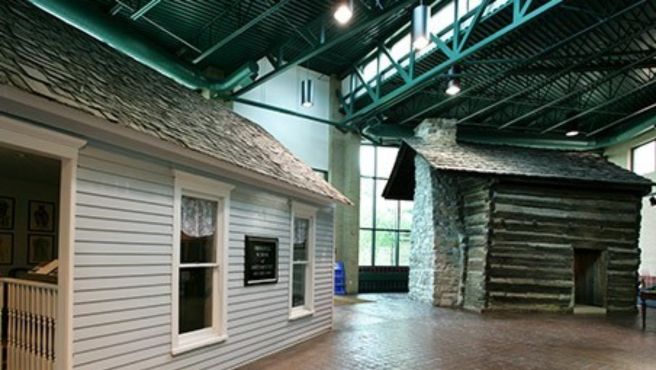
Figure 1. The current lobby of the Museum of Osteopathic MedicineSM [Image source: home page of the Museum’s website. Courtesy of the Museum of Osteopathic Medicine]
The current structure of the museum, as it stands today and serves the international osteopathic community, is the result of decades of devoted efforts from its staff and numerous volunteers. This achievement has been made possible through generous donations and the dedication of the successive directors who have guided the facility over the years, playing a crucial role in its development and increasing significance.
The first initiative aimed at preserving items testifying the history of osteopathy dates back to 1934 and was put in place by the Psi Sigma Alpha, a fraternity of students of Kirksville College of Osteopathy and Surgery (KCOS). This college had been founded in 1926 and had inherited the legacy of the ASO after the complicated events following the death of Dr. A.T. Still [1].
The artifacts collected in the first Museum, named A.T. Still Memorial Museum, were arranged in two display cases that housed about fifty personal artifacts belonging to Dr. Still, almost all of which were donated by Blanche, his youngest daughter (Figure 2). The collection included a home-made neck-support crafted by Dr. Still to relieve headaches, a pair of boots, several walking staffs and a model of the railroad switch he had devised [2]. During the following years, several other objects enriched the collection cases, which were kept on display until the 1960s. Nevertheless, no particular initiative was taken to advertise it or expand it further.
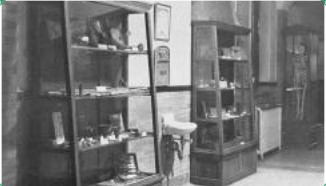
Figure 2. The two display cases that originally housed the first osteopathic historical artifacts, located in the main lobby of the KCOS administrative building, 1936. [Image sourse: [2]. Courtesy of the Museum of Osteopathic Medicine]
In 1971 the KCOS college of osteopathy changed its name into Kirksville College of Osteopathic Medicine (KCOM). In the same year, a more visible location was found to exhibit the log cabin where Dr. A.T. Still was born, which was moved near the first ASO building (Figures 3 and 4).
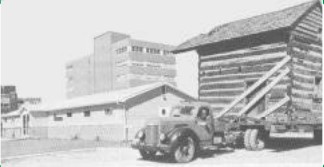
Figure 3: Relocation of Still’ log cabin, 1971. [Image source: [2]. Courtesy of the Museum of Osteopathic Medicine]
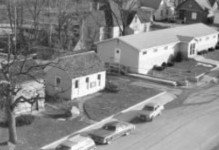
Figura 4: Relocation of the historical buildings next to the Museum, 1982. [Image source: [2]. Courtesy of the Museum of Osteopathic Medicine]
By the mid-1970s, the continued growth in number of gifts and other donations from retiring physicians, professors, and Still family members prompted the Museum to actively identify itself as the sole repository of osteopathic history. It then began advertising, sought funding, and underwent a name change, transforming into the Still National Osteopathic Museum (SNOM). In 1978, the SNOM reconstituted itself as an independent nonprofit organization, and by 1980 it relocated into the building next to Still‘s log cabin and to the first ASO’s headquarters (Figure 4). The collection of 965 artifacts was rearranged and housed in 19 display cases within the new premises (Figure 5). At that time, two part-time employees worked at the museum, supported by a group of volunteers who, over the following decade, were responsible for carrying out most of the tasks [2].
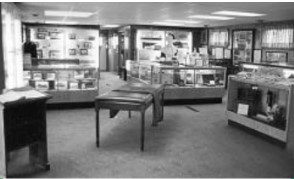
Figure 5: The exhibition housed in 19 display cases in the museum’s renovated headquarters, 1980. [Image source: [2]. Courtesy of the Museum of Osteopathic Medicine]
The new location was equipped with a reading room, providing visitors access to the school’s yearbooks, numerous historical medical journals, and an extensive collection of photographs. A specific area was set up for the gift shop (including a reprint of Dr. A.T. Still‘s Autobiography, edited by the Applied Academy of Osteopathy (AAO)). A campaign was also launched to solicit new supporters, while in 1981 the video “Preserving a Heritage“, on the history of osteopathy and on the Museum itself, was produced. In 1982, the Museum became a charted affiliate of the American Osteopathic Association (AOA), the association that has brought together American osteopaths since the early twentieth century, playing a key leading role in the development of the profession [2].
Although this affiliation did not entail any tangible financial support for the Museum, it had the effect of increasing its visibility and fostering its growth. In 1984 the Museum organized an exhibition on the history of the fifteen existing osteopathic colleges. Two years later, in 1986, improved financial conditions made it possible to hire its first director, although only on a part-time basis [2].
As the centenary of the founding of the ASO approached in 1992, the areas designated for both the KCOM and the Museum underwent a re-planning. In the Spring of 1994, they were redefined in a way that resembles their current appearance, while the following year they were finally occupied. New staff was also hired and the strategies, standards and protocols for the care of the collections were refined. Subcommittees were created for collection care, fundraising, and public relations [2].
In 1996, the Museum was incorporated into the KCOM and received an annual fund to cover expenses. In an effort to streamline operations and merge the two artifact collections, the following year the Museum obtained the ownership and management of the special collections belonging to the KCOM’s library, the A.T. Still Memorial Library, whose official name was National Center for Osteopathic History (NCOH). This collection consisted of several thousand artifacts, including osteopathic journals, original manuscripts, photographs, and personal belongings of the Still family. The increase of the Museum’s holdings called for standardization of the cataloging system, and the new availability of the NCOH spaced made it possible to separate the public areas from the administrative quarters. Between 1998 and 2000, the Museum continued to expand, implementing some improvements in lighting, adopting innovative technologies, and redistributing available space to achieve a more effective operational system [2].
In 2001 Jason Haxton, MA, DO (Hon), was appointed director of the Museum. A Kirksville native, Haxton [2] is renowned within the osteopathic community for his passionate and tireless dedication to disseminating information about the history of osteopathy. Since 2005, he has welcomed guests from around the globe, delivering many international seminars, both in-person and online [3].
Around 2003, the Museum acquired a computerized system to catalog the collections, with the intention of making available online as many items as possible to the researchers [2].
The generous funding received in 2009 from the federal Institute of Museum and Library Services and the additional financial support provided by the Missouri Digital Heritage Initiative allowed work to be continued on the online publication of hundreds of artifacts (including some manuscripts by Dr. A.T. Still), to welcome more than six thousand visitors, and to organize 63 courses for students and professionals [4]. A new space allocation was also planned to improve the services provided, described in great detail in the Spring bulletin of the year 2009 [3]. It was at that same time that the NCOH changed its name and became the International Center for Osteopathic History (ICOH) in order to emphasize the international nature of its mission [3].
To give an idea of the Museum’s evolution, here is a table documenting the Growth of the Museum’s Square Footage Through the Years (Figure 6) [3].
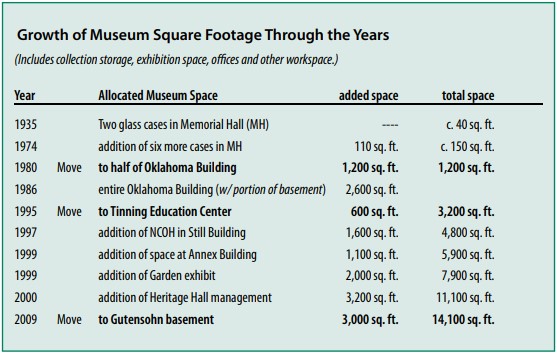
Figure 6. Growth of the Museum’s Square Footage Through the Years. [Image source: [3]. Courtesy of the Museum of Osteopathic Medicine]
It is not possible to list here all the Museum’s initiatives and activities, many of which are described on the news page of its website, to which we refer for more details [5]. Just by way of example, a few are mentioned below.
On June 22, 2010, the Museum announced that it had adopted a new name: as of that date the Still National Osteopathic Museum took the name of Museum of Osteopathic MedicineSM, A.T. Still University [6].
In 2011, the Museum and the ICOH received a donation from the Cranial Academy Foundation to preserve the collection of Viola Frymann, DO, FAAO, FCA [7].
In 2013, the Museum of Osteopathic MedicineSM announced its membership in the Blue Star Museum initiative to offer free visiting days to active-duty U.S. military personnel and their families [8].
In 2013-14 the Museum was granted the Advocates for the American Osteopathic Association (AAOA) Special Project’s Grant for the production of educational catalogues and a recycling bin for the museum’s Historic Medicinal Plant Garden [9].
In 2022, the Museum of Osteopathic MedicineSM at the A.T. Still University (ATSU) of Kirksville, Missouri, achieved accreditation by the American Alliance of Museums (AAM), the highest national recognition afforded the nation’s museums. Alliance Accreditation brings national recognition to a museum for its commitment to excellence, and at the time it had been awarded to just over a thousand national museums out of the approximately thirty-three thousand in existence. At that time, the collections of the Museum of Osteopathic Medicine included more than eighty thousand objects, photographs, documents, and books, dating from the early 1800s to the present day. The core of the collection consisted of artifacts coming from Dr. A.T. Still‘s professional and private life, most of which were donated by his daughter Blanche Laughlin and other family members [10].
In October 2023, the Wall of Honor was unveiled at A.T. Still University (ATSU) of Kirksville in recognition of the generosity of many people who supported its work (Figure 6) [11]. A short video on YouTube serves as a testament to the poignant ceremony [12].

Figure 7. The Wall of Honour unveiled in October 2023. [Image source: [11]. Courtesy of the Museum of Osteopathic Medicine]
- Walter The First School of Osteopathic Medicine di Georgia Warner Walter. Thomas Jefferson University Press, Kirksville, Missouri. 1992:152).
- Still National Osteopathic Museum – National Center for Osteopathic History. Now and then. Spring 2005. https://www.atsu.edu/museum-of-osteopathic-medicine/wp-content/uploads/2019/05/museum_spring_05.pdf.
- Still National Osteopathic Museum – National Center for Osteopathic History. Now and then. Spring 2009. https://www.atsu.edu/museum-of-osteopathic-medicine/wp-content/uploads/2019/05/museum_spring_09.pdf.
- https://www.atsu.edu/news/still-national-osteopathic-museum-receives-125k-collection-stewardship-grant
- https://www.atsu.edu/news/category/museum-of-osteopathic-medicine
- https://www.atsu.edu/news/new-name-for-the-museum
- https://www.atsu.edu/news/museum-of-osteopathic-medicine-awarded-grant-from-cranial-academy-foundation]
- https://www.atsu.edu/news/museum-of-osteopathic-medicine-to-participate-in-blue-star-museums-2].
- https://www.atsu.edu/news/museum-of-osteopathic-medicine-awarded-grant
- https://www.atsu.edu/news/museum-of-osteopathic-medicine-receives-highest-national-recognition-awarded-accreditation-from-american-alliance-of-museums]
- https://www.atsu.edu/news/a-t-still-universitys-museum-of-osteopathic-medicine-unveils-honor-wall].
- https://www.youtube.com/watch?v=Pf8adHyy_BY&ab_channel=A.T.StillUniversity

Are you an osteopath?
Register and enjoy the membership benefits. Create your public profile and publish your studies. It's free!
Register now
School or training institution?
Register and enjoy the membership benefits. Create your public profile and publish your studies. It's free!
Register now
Do you want to become an osteopath? Are you a student?
Register and enjoy the membership benefits. Create your public profile and publish your studies. It's free!
Register now







